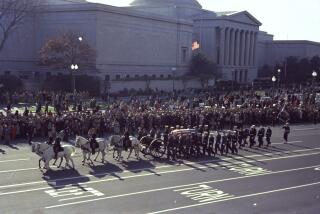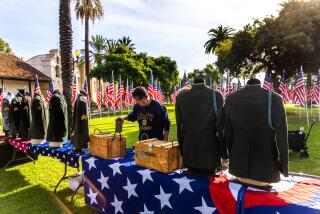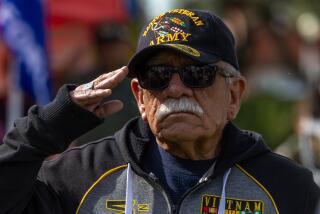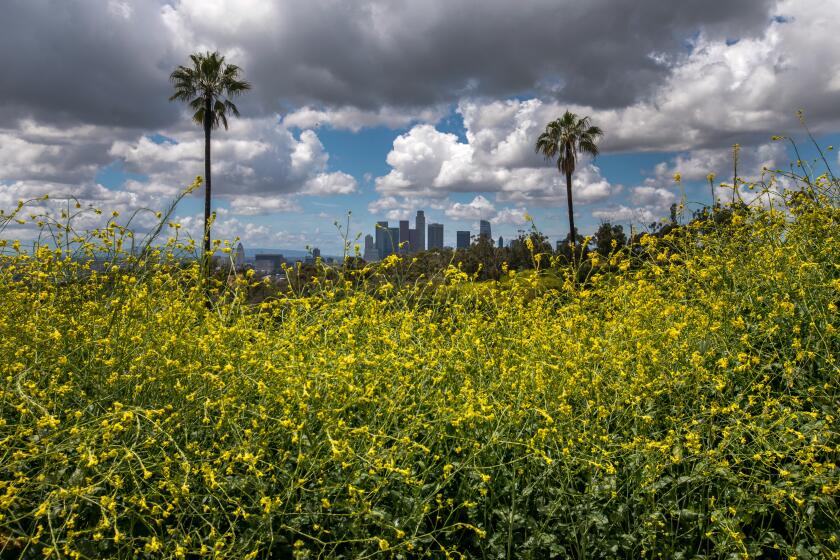Memorial Day: Tokens of rememberance

My son, Marine Corps Lance Cpl. Donald J. Hogan, was killed in Helmand province in August 2009. In the days and weeks that followed, my wife, Carla, and I spent a lot of time with the 100 or so Marines who served with him. We asked them what they needed most, and the answer was unexpected.
Infantry members spend all their time on their feet. They have no laundry facilities, so they wash their socks in irrigation canals and air-dry them. But the sand and grit make them unusable again within a couple of days. Again and again we heard this request: “Send us socks.”
So that’s what we do. Socks for Heroes, we call it. So far, Carla and I, with the help of generous contributors, have sent almost 200,000 pairs to Afghanistan. We are grateful for the opportunity to help. It is a memorial to our son.
DATABASE: California’s War Dead
There is another memorial as well, of course. My son rests at the Ft. Rosecrans National Cemetery in Point Loma, which juts into the ocean and forms part of the entrance to San Diego harbor.
It is a beautiful, tranquil place not far from our home. We feel fortunate that he is there; when he was killed, we thought there was little chance that we could find him a space at Point Loma. And yet the cemetery’s director, Kurt Leopard, surprised us. “Combat casualty?” he said. “We’ll pull up a tree if necessary to make room for him.”
I don’t go there often — it is still painful for me — but not long ago I promised my older son that I would deliver flowers to the cemetery for him.
My son’s grave site is two rows in from the road. Next to him, on the right, is a Marine corporal who served in World War II and died in 1951. I looked at the dates on the stone; he was 37 years old when he passed. There is a Marine captain in front of him who lost his life in the Korean conflict. Behind him to the left is a veteran of the Spanish-American War.
I drove and then walked to Donald’s grave. I pushed a flower stand into the hard ground and set in it two bouquets, chosen for their flash of bright color. Then I noticed there was a quarter on his gravestone. I looked a little closer. At the base, a woman’s silver-strand bracelet was pushed firmly into the dirt.
The quarter is part of an old tradition that started in Roman times of leaving coins on grave markers to let the families of the fallen know that their son’s or husband’s comrades had come to visit their graves.
Today, the symbolism of the coin is that the higher the value, the closer the relationship between the fallen and the person leaving the coin. A nickel means they went to boot camp together, a dime means they served together, and a quarter means they were together when he was killed.
I wondered who had left it.
It didn’t really matter. I was grateful for the gesture.
I was also curious about the bracelet. At my son’s memorial service, a few different young women introduced themselves to us as “his last girlfriend.” We were, to say the least, amused. Was it one of them who paused to leave that token?
I sat for a few minutes. I touched the stone and said goodbye, again. In the background, volunteers from the Rotarians, who clean the grave sites, waited respectfully until I was finished before beginning work on that section of the cemetery. A young woman walked forward and asked, “Is it your son?” and I nodded. I could see tears forming in her eyes, and I felt them forming in mine.
I had timed my visit so that I wouldn’t be alone afterward. I went sailing. My partner on the boat was a man who lost his son to leukemia a decade ago. Being with him reminds me that I am not alone in my loss.
The day before, while I was shipping socks from the post office in San Clemente, a woman came by and asked me what all the crates were for. I told her. She asked if I had served; I said no, but my son did, and that he had died in Afghanistan. She said she was sorry, and then: “So this is your healing.”
Later, I thought about her comment. Maybe some wounds are too deep to heal. I don’t know.
What I know is that I am paying a debt. It is owed to those who have served our nation and still serve today. I want a Marine or a soldier somewhere to know that he or she isn’t forgotten, just as the Marine who left a quarter and the young woman who left her bracelet have not forgotten my son.
Socks for Heroes, socks for comfort — theirs and mine.
Jim Hogan is a San Clemente technology consultant. Portions of this piece appeared first on the Socks for Heroes website and Facebook page.
More to Read
A cure for the common opinion
Get thought-provoking perspectives with our weekly newsletter.
You may occasionally receive promotional content from the Los Angeles Times.






